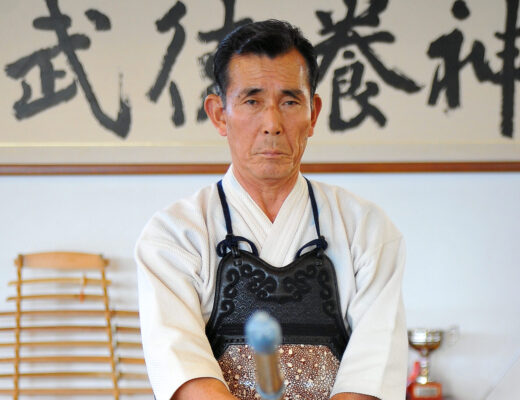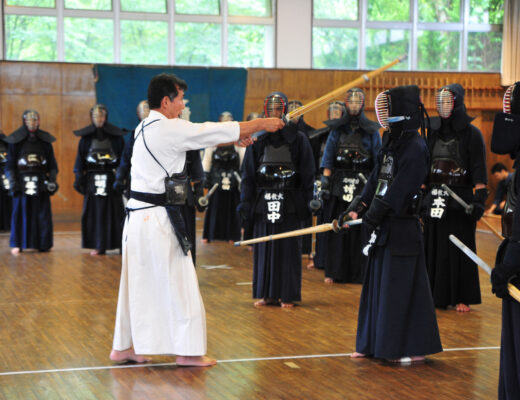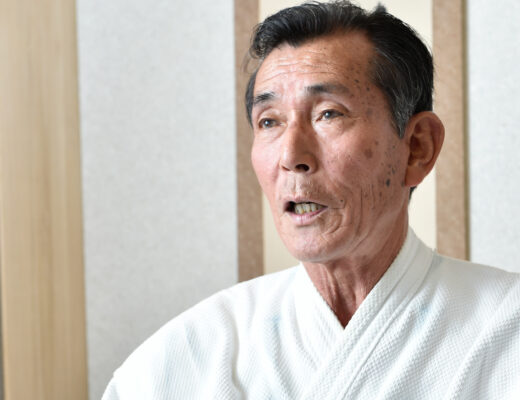2019.6 KENDOJIDAI
Let’s aim for a deeper and stronger Kendo in accordance with the original principles of the sword. The first is to strike with the correct Hasuji (blade angle). This is a requirement for valid strikes. Second, use Shinogi (back of the blade) to perform Oji-waza. This will allow Suriage- and Kaeshi-waza to become brilliant Ippon. I will explain how to skillfully use Hasuji and Shinogi.
Sumi Masatake, 8th Dan Hanshi
Born in Fukuoka Prefecture in 1943. After graduating from Chikushigaoka High School, he moved on to Fukuoka Gakugei University (now Fukuoka University of Education). After graduation, he worked as a high school teacher before returning to his alma mater, Fukuoka University of Education, as an assistant. He served as a professor at Fukuoka University of Education and as the head of the Kendo Department. Currently, he is a professor emeritus and Kendo instructor at Fukuoka University of Education, an instructor at Kyushu Electric Power Company’s Kendo club, and an instructor at Chikushigaoka High School’s Kendo club.
Striking from your core
Transfering striking force to the Mono-uchi
As stated in the requirements for effective strikes, you have to “strike with the correct Hasuji”, Kendo requires striking with the blade’s edge. In addition, Japanese swords have Shinogi, and even with a Shinai, Shinogi actions can be used skillfully for effective Seme, and also for Oji-waza.
In order to be able to use the basic strikes for the Men, Kote, Do, and Tsuki, it is important to understand the issues involved in the development process from basics to application.
In order for the basic strikes to manifest as a technical skill in a duel, the basic strike must be accompanied by efficiency of motion. That is, the ability to produce the maximum sufficient effect with the minimum amount of energy. Naturally, one must learn how to strike in accordance with the basics, and one must be aware of Hasuji and Shinogi. In terms of Shinai handling it is important to smoothly transmit the supple movements of the arms to the Shinai. In terms of footwork, it is important to coordinate Okuri-ashi foot for a sharp Seme, and the right foot’s quick and powerful Fumikomi sustained by the left foot for a sharp forward movement of the whole body.
In Kihon Keiko for adults, the common method is to agree on the striking target with each other, so I will first introduce the points to note for Men-strikes and Kote-strikes.
Nowadays, it is common to see young beginners and intermediates leaning forward and going in head first, but if you want to become a 6th, 7th, or even 8th Dan practitioner, you should aim for a more core driven Men-strike.
The basic principle of Men-strikes is to have a sharp strike with maximum power concentrated in the Mono-uchi part.
In addition to the snap of the wrist, the arms should move up and down, and the direction in which the force is applied to the striking target should be diagonally downward, not forward. To stabilize the axis of the body, striking from the waist is required.
The true way to strike the Kote-strikes is to swing down with an aligned blade angle. If you don’t use your elbows and shoulders to swing up sufficiently, you will not be able to perform a sharp technique. In general, striking Kote where the opponent is just standing will not result in an Ippon. You have to be aware of the changes in the opponent’s Kamae, so the Moto-dachi should always initiate a movement to create an opening for you to strike.
Kaeshi- and Suriage-waza
Use the Shinai in an arch
The rest of this article is only available for Kendo Jidai International subscribers!





